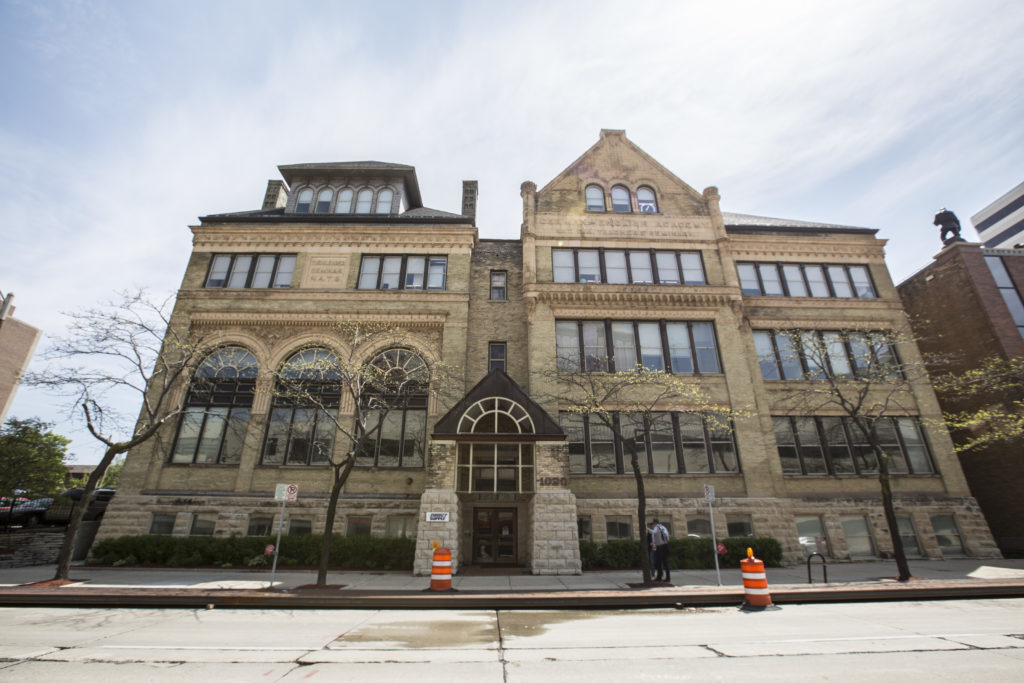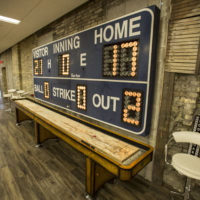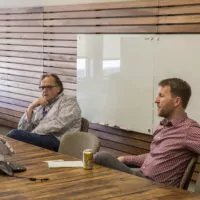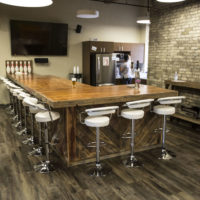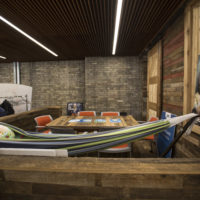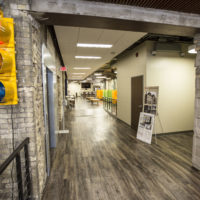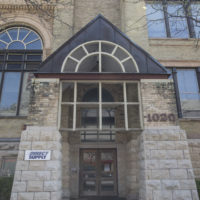Beer, sausage, and senior living innovation.
That might sound like an odd combination to most people, but not those who know about the Direct Supply Innovation Center in downtown Milwaukee. It is turning the largest city in Wisconsin—already famous for its suds and bratwurst—into a hotspot for cutting-edge senior living technologies.
Unveiled by senior living equipment and solutions giant Direct Supply in 2015, the Innovation Center is located on the third floor of a historic neo-Gothic building (pictured above). Furnished with a vintage scoreboard from the Brewers’ old County Stadium—and a bar with working beer tap—the space is Milwaukee-proud while exuding Silicon Valley cool. This is the setting where 28 startups currently are incubating technology, like “virtual field trips,” that could help define the future of senior living.
Innovation Center Managing Director Tom Paprocki and Direct Supply Executive Creative Director Tom Hansen recently spoke with Senior Housing News about how the center works and what they see for the future of senior living tech, including how providers can avoid “pilot purgatory,” and why the last two years have been a turning point for the industry.
Why was the Innovation Center created?
Tom Paprocki: It’s really hard to change this industry, hard to bring innovation and actually have it effectively implemented, and since we do touch as many buildings as we do, and work with as many operators as we do, and have a reputation that we’re not just here for a dollar today, I think there was an opportunity to become more actively involved as an intermediary, where we help test and effectively bring some of this tech to customers where it can do some good.
One of the keys for us is helping senior care customers winnow through what’s important to them.They might hear about artificial intelligence [AI] and like every other consumer, they’re interested. We’ll put the eye on how that could benefit you in the business that you’re in. Some of that is so they don’t spin their wheels on tech that might not be appropriate.
Tom Hansen: It’s based on what we saw as a customer need … we spend so much time with our customers trying to understand what they’re up against, this sort of stuff grows out of it. It’s the opposite of being recognized as a tech company, [just saying] let’s make a bunch of robots. All 28 [of our startups] have some granular, tangible reason why we think they might make a difference.
How are you finding the startups that are working out of the center?
TP: We used to have to hunt. Now they find us. A question in any business plan is, how are you going to get this to market, and [entrepreneurs] ask around and hear, you should talk to Direct Supply …. It’s also very strange how networks work. I find it fascinating. A week and a half ago, I had the producer of The Deadliest Catch in here working with us on something for VR [virtual reality]. Everybody is connected.
How do you decide what new technologies to work with, which ones have the greatest potential to make a difference for your senior living customers?
TP: There are four buckets. Does it help [the senior living provider] make more money? Is it either going to drive occupancy or improve revenue per bed through bolt-on services? Will it lower the cost of delivering health care or lower the cost of operating the physical plant? Does it improve access either through the ability to reach seniors within some given radius of your building or improve rural health, or does it demonstrably improve outcomes?
What are some of the ways you support these startups?
TP: [Most entrepreneurs in this space] had a parent go through something or a grandparent go through something, and they find out how crazy it is, and they say, well, I’m going to fix that. They don’t understand how reimbursement works, they don’t understand how regulation works, so we provide a lot of expertise around that.
Do you invest in them directly?
TP: No. We facilitate investments. I’m just about to finish an A-round for a company that’s about a $3.5 million raise. It’s not our money, but I do a ton of calls with potential investors.
Would you invest at some point down the line?
TP: Here’s the challenge. Part of the reason I think we’ve been successful as a company is that we’ve always been impartial. We sell to 95% of the communities in the country, and we never say, “Hey, you need to buy this product or that one.” We’re far more consultative than that. We want to make sure that our customers buy the product that’s best for them. If we have an equity position in a startup, we do have to face the very real issue of optics. In the end, we’re an employee-owned company that always has its customers’ best interests at heart. That having been said, the best products and solutions of the future will be increasingly complex and holistic, and we want to play an active role in testing and making sure that the best solutions win. That’s because our customers simply don’t have the time or resources to make sense of the tidal wave of options. If we can invest and do that in a way where we feel like we’re still being honest, then, yes, we would do it.
The more daring you get on the innovation side, the more the antibodies come out. Ultimately there’s a reason we’re on a different campus and have some cultural and geographic insularity from the mothership. It’s because the company and the industry know that we need this, even though it’s uncomfortable sometimes. Even now, I think a great deal of what we’re working on is a bit much for some people. To slap investment on top of that might lead to cardiac arrest, so we’ll ease into that over time. For now, we still help entrepreneurs considerably on the funding side of the equation by working closely with other investors. What we really offer is access and unmatched industry expertise, and those are things that are critical both to inventors and investors.
How are you defining success?
TP: At the end of the day, we’re an employee-owned, mission-driven company. We still need to make money, but we have a number of metrics. Some are financial and some are more about how you actually move the needle on getting some of this stuff to the finish line, because so many things stall out, and we want to get them through and be the partner of choice with what we see as the best innovators out there in senior care.
How much are you investing into the Innovation Center in the coming years, is there a number?
TP: Not really. It’s well into the seven figures.
Is there enough talent in Milwaukee to be the hub of senior care?
TP: I’ll be super honest. No. At least not yet. But there doesn’t have to be, because out of the 28 startups we work with, only six, soon to be seven, are here. The rest are all over the world. One of them is moving to Milwaukee from Europe next month, and honestly it’s probably at least partially for the beer and the cheese. I believe there’s actually a lot of talent here, and we’re also very close to Chicago. But this is going to take an effort that’s far bigger than any location, whether it’s San Francisco or Boston or wherever. Do I think we can play a key role in driving a lot of this? Absolutely.
Aging 2.0 is based in San Francisco. Why would a startup come to work with you versus that organization?
TP: I don’t think it’s a space where there’s a choice in many cases … We don’t necessarily compete. If any of this stuff is going to work, there has to be more collaboration across those nodes in the system. I talked to Aging 2.0 last week and will talk to them later this week.
And you’re also supporting startups by connecting them with senior living or skilled nursing companies to do pilots?
TP: Yes. It’s a challenging thing … if this were the airline industry, you’re selling to the four [big] carriers, and then you’ve got the little guys. [In senior living], Brookdale is by far the biggest, and they’re still less than 3% of the total market. So it’s really hard to scale.
We do help startups pilot, and I think a lot of senior living providers, it’s been a little bit of an education, because they don’t necessarily understand what the difference is between an alpha test and a beta test and a pilot. So we’ve facilitated quite a bit of that, to get technologies out there and tested early, because sooner or later you’re going to have to test it. We facilitate that.
It seems that we hear a lot about pilots but almost never about a pilot scaling up across a whole company. Why the disconnect?
TP: I think it’s a tricky thing. Everybody’s busy, and everybody will tell you that they want to be innovative—until they find out it requires work.
That is, it requires a great deal of work and coordination to do it right. Their focus is on providing care, as it should be.
I can’t remember the last time I talked to a customer and they didn’t have concerns around staffing. They don’t have enough people, good people, and if you don’t have that, how do you allocate resources to driving some of these pilots? What typically happens, what I see happen is, someone will agree to do a pilot, but the pilot basically means we’re going to try out your product. It was never established ahead of time what you’re trying to measure and if you hit that measurement, what happens.
They kind of wind up in this pilot purgatory. It’s not a bad thing, it doesn’t end up moving forward, though. It just ends up trapped there because no one knew why they were testing it.
TH: And then rolling out typically requires some kind of substantial cap investment. Even in its strongest moments, the industry has never been rolling, margin-wise, so you always hear the cliche that the senior living industry is slower to adapt to technology. But there are reasons for that.
We’re always aware of not bringing in technology for technology’s sake … We’re always looking at the applications of the technology, how it’s going to connect with somebody. If I’m an operator and there’s another change and expense I have to manage, I better be sure what the outcome is.
Is there an ideal size for a provider to be, to pilot a new technology?
TP: Usually not big companies … if you don’t want to get weighed down with the legal department and the soul-crushing bureaucratic machines. There are some exceptions to that, and it also really depends on what the technology is. But the company should be big enough that if the tech hits, it can scale in the organization. So, generally speaking, and this is an oversimplification, I would say 10 to 50 [buildings]. For the things that are more out there, we’ll go smaller groups. It’s surprising how open people are getting. I think in the last two years, it’s changed.
Why?
TP: The Silent Generation was just like, I grew up in the Great Depression, I’m good. There’s a lot more openness now, and more of our customers view [tech] as a way of doing resident engagement.
Everybody is talking about how the Baby Boomers are coming. If you ask people what the name of the generation that preceded them, usually they don’t know. And I suppose that makes sense, because the answer is not The Greatest Generation, it’s actually The Silent Generation. It’s a fitting name, I think, because this is a group that grew up during the Great Depression. They were accustomed to just enduring whatever they were faced with. The Baby Boomers do have different expectations, and the savvy operators out there know that some of these innovative products and technologies can help them deliver the different style and quality of experience that these new customers are going to want and expect.
And yet there’s the WiFi test. Do you think providers have enterprise WiFi to run half these applications?
TP: No, you’re 100% right. I met with one of the CIOs of one of the largest care providers last year, and went pretty deep into what’s next, social robotics and VR and AI [artificial intelligence], and he’s loving all of it. And I said, what’s your big goal for 2016? He said, well, I want to get functional wireless in 80% of my buildings. It’s a huge problem.
Do the startups realize where the industry is at?
TP: They don’t at all. A lot of these guys come out of the cradle of tech. Silicon Valley, or Boston, or Austin, Texas, and [they] assume it. Who doesn’t have WiFi? And then the first time they try to go and run some sort of tests? Ah.
Do they get frustrated? Do they say, why am I doing this if the industry is not ready?
TP: They do. But I think obviously this is the best time for innovation in senior care that I’ve ever seen … I think the industry’s more open to it. People understand they need to adapt, or else … [at Direct Supply] we build a lot of new buildings, do hundreds of renovations a year, and on the tech side they say, what do I need to think about? You have to have functional wireless in your building. If you’re going into assisted living or independent living, you’re probably bringing your own iPad or tablet in there, and people are not going to like it if they get in their room and there’s no connectivity.
TH: There’s a demand that’s starting now, but boy, in the future, that’s table stakes … [Direct Supply] since the beginning has invested in senior care, so some of the startups get discouraged, but it’s a longer game, and by the nature of how we’ve been positioned—this whole venture—we’re willing to invest in what’s next. I don’t know when “next” is, but it’s around the corner. And in the meantime, we’ll continue to vet and test and see.
Written by Tim Mullaney with reporting contributed by John Yedinak

